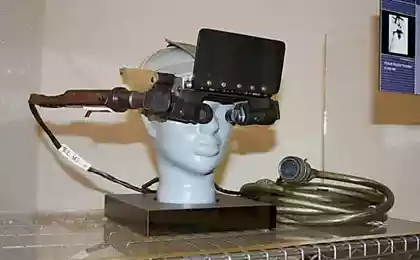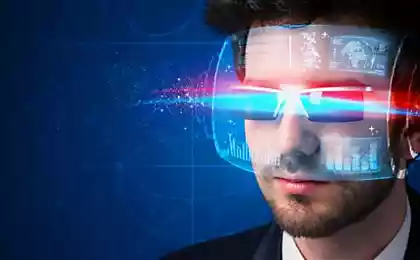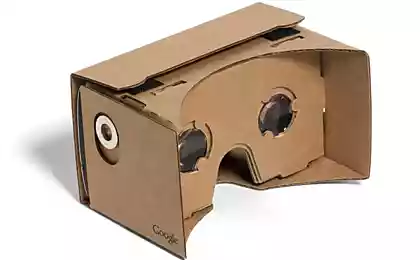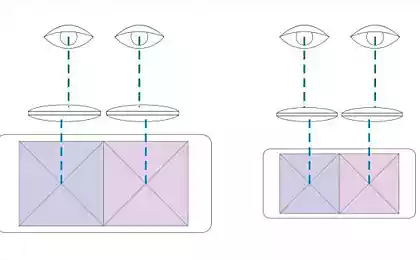563
By 2020 people will spend most of your time in virtual reality
Fifty seven million one hundred fifty eight thousand nine hundred twenty two
Interestingly, forecasts in the short term, tend to be very conservative — most people envision the future in the form of a slightly extended version of the present. People think that most major social changes have either already happened or will happen in the distant future, but it is far from the truth. The world is changing faster than ever before, and a number of technologies that are already in active development, will change it beyond recognition. Among them — self-driving cars and virtual reality. About it, we'll talk.
There are three basic axioms that need to be understood, trying to predict the near future:
In ten years the most popular technology is unlikely to be a novelty — it will be smaller, faster, easier, more convenient, more compact and cheaper than what we have today. The best technology today is used to create the technology of tomorrow, causing technologies to improve exponentially. As the exponential growth of technology, the level of adoption grows symmetrically. It is also important to note that network effects accelerate the development of many new technologies. Network effect means that the value of technology depends on the number of people using it: the first phone was not value for its owner, but was it when you increased the number of people able to call. The phone has become valuable only when the technology became exponential distribution.
Why most predictions about the future are incorrect, There is one fundamental reason why many predictions are very wrong: experts and analysts attempt to use linear models to predict the level of adoption of technologies that evolve exponentially. This happens mostly because they assess the technology's potential based on its current form and function; the reality is that this technology every year will get better and better.
Futurist Zack Kanter leads a good example. In 1980, AT&T hired consulting giant McKinsey to the predicted market size of mobile phones. Based on the slow historical acceptance and the shortcomings of this technology — heavy device, horrible battery life, poor coverage and absurd cost — McKinsey famously predicted that by 2000, the total market will hardly reach a million subscribers. In fact, this number has exceeded 100 million.
Although the analysis McKinsey may seem funny from our point of view, the truth is that few at the time foresaw the explosive growth of mobile phones in the coming years. In fact, quite easy to follow the thinking of analysts: at that time cell phones were terrible and the growth seemed linear and only when we look at the chart from a distance, it becomes clear that the growth in adoption has been exponential.
Virtual reality is ready for widespread Many people see virtual reality in black and white colors: it will be a novelty until then, until it becomes a real Matrix. But virtual reality can't compete with a perfect simulation of the real world — it competes with traditional sources of media: TV, radio, smartphones, tablets, and computers. Those who have reached the legal age, already spend at least 8 hours. And good virtual reality technology for the people has ceased to be a pipe dream — it already exists. Oculus Rift gives a great experience of fun, and a consumer version will be ready in 2015 at a price of 200-400 dollars apiece.
The consumer behaviour described above is well established, which means that the technology will soon be inexpensive and available everywhere. It would be foolish to believe that virtual reality will not be at the hearing of the people in the next 5 years — moreover, the consumption in this area will increase with increasing content and user experience will improve exponentially.
In other words, I believe that most people would prefer to spend time in virtual reality, watching some "Game of thrones", playing Call of Duty or just porn.
The network effect of virtual reality will be huge. As more people will use virtual reality to grow and the platform; it will become more attractive to lure new users and continuing the cycle.
BP-oriented world
We can't imagine how virtual reality will evolve as a medium — perhaps the most interesting is the separation of the virtual experience a La p2p. Imagine a YouTube-like interface where you can immerse yourself in the real three-dimensional environment, created by someone else. Of course, we will see mass production of content, including traditional approach is top-down from the media giant and film studios.
But this is only the tip of the iceberg. Entire markets are formed exclusively within a virtual reality, perhaps allowing it to flourish, finally, the cryptocurrency of the Bitcoin type. Enterprise applications are often overlooked — but just imagine how many jobs forms of virtual reality, of course, in the next 10-15 years.
In the real world around the virtual reality will not be without winners and losers. Users will have less time for cooking, and it can be assumed that food alternatives like "Soylenta" will become very popular, as well as delivery services and catering. The cinemas will surely die with them, and a major live streaming services (if you don't adapt, of course). Who will be able to successfully transform a 2D experience into a thrilling virtual reality experience? Facebook, YouTube, Netflix and Google will have to step it up.
Although, of course, the market will develop associated with the virtual reality devices and accessories — even our home furniture will undergo significant changes — virtual reality kill the whole product category. Giants like Amazon won't like it.
Perhaps the biggest problem is the threat of virtual reality for our health and well-being. We know that sitting kills — lack of physical activity is included in the ten leading factors causing death worldwide, and a virtual way of life will certainly exacerbate a lot of problems related to obesity and inactivity. Certainly there are some innovative approaches in the pharmaceutical industry, preserving muscle mass and bone density, as well as active methods like treadmills for virtual reality. Many bright minds are already trying to address these issues in another context: for a successful flight to Mars need to find a way to preserve the health of cosmonauts in ruinous conditions of weightlessness. Elon Musk, for example, plans to explore Mars by 2026.
He laments the fact that in every corner of the Earth looked, but before us spread the limitless expanses of space. However, there is another epic journey that we have to make, by examining the boundary that extends endlessly inside: in our minds, in the first universe created us.
Source: hi-news.ru
Interestingly, forecasts in the short term, tend to be very conservative — most people envision the future in the form of a slightly extended version of the present. People think that most major social changes have either already happened or will happen in the distant future, but it is far from the truth. The world is changing faster than ever before, and a number of technologies that are already in active development, will change it beyond recognition. Among them — self-driving cars and virtual reality. About it, we'll talk.
There are three basic axioms that need to be understood, trying to predict the near future:
In ten years the most popular technology is unlikely to be a novelty — it will be smaller, faster, easier, more convenient, more compact and cheaper than what we have today. The best technology today is used to create the technology of tomorrow, causing technologies to improve exponentially. As the exponential growth of technology, the level of adoption grows symmetrically. It is also important to note that network effects accelerate the development of many new technologies. Network effect means that the value of technology depends on the number of people using it: the first phone was not value for its owner, but was it when you increased the number of people able to call. The phone has become valuable only when the technology became exponential distribution.
Why most predictions about the future are incorrect, There is one fundamental reason why many predictions are very wrong: experts and analysts attempt to use linear models to predict the level of adoption of technologies that evolve exponentially. This happens mostly because they assess the technology's potential based on its current form and function; the reality is that this technology every year will get better and better.
Futurist Zack Kanter leads a good example. In 1980, AT&T hired consulting giant McKinsey to the predicted market size of mobile phones. Based on the slow historical acceptance and the shortcomings of this technology — heavy device, horrible battery life, poor coverage and absurd cost — McKinsey famously predicted that by 2000, the total market will hardly reach a million subscribers. In fact, this number has exceeded 100 million.
Although the analysis McKinsey may seem funny from our point of view, the truth is that few at the time foresaw the explosive growth of mobile phones in the coming years. In fact, quite easy to follow the thinking of analysts: at that time cell phones were terrible and the growth seemed linear and only when we look at the chart from a distance, it becomes clear that the growth in adoption has been exponential.
Virtual reality is ready for widespread Many people see virtual reality in black and white colors: it will be a novelty until then, until it becomes a real Matrix. But virtual reality can't compete with a perfect simulation of the real world — it competes with traditional sources of media: TV, radio, smartphones, tablets, and computers. Those who have reached the legal age, already spend at least 8 hours. And good virtual reality technology for the people has ceased to be a pipe dream — it already exists. Oculus Rift gives a great experience of fun, and a consumer version will be ready in 2015 at a price of 200-400 dollars apiece.
The consumer behaviour described above is well established, which means that the technology will soon be inexpensive and available everywhere. It would be foolish to believe that virtual reality will not be at the hearing of the people in the next 5 years — moreover, the consumption in this area will increase with increasing content and user experience will improve exponentially.
In other words, I believe that most people would prefer to spend time in virtual reality, watching some "Game of thrones", playing Call of Duty or just porn.
The network effect of virtual reality will be huge. As more people will use virtual reality to grow and the platform; it will become more attractive to lure new users and continuing the cycle.
BP-oriented world

We can't imagine how virtual reality will evolve as a medium — perhaps the most interesting is the separation of the virtual experience a La p2p. Imagine a YouTube-like interface where you can immerse yourself in the real three-dimensional environment, created by someone else. Of course, we will see mass production of content, including traditional approach is top-down from the media giant and film studios.
But this is only the tip of the iceberg. Entire markets are formed exclusively within a virtual reality, perhaps allowing it to flourish, finally, the cryptocurrency of the Bitcoin type. Enterprise applications are often overlooked — but just imagine how many jobs forms of virtual reality, of course, in the next 10-15 years.
In the real world around the virtual reality will not be without winners and losers. Users will have less time for cooking, and it can be assumed that food alternatives like "Soylenta" will become very popular, as well as delivery services and catering. The cinemas will surely die with them, and a major live streaming services (if you don't adapt, of course). Who will be able to successfully transform a 2D experience into a thrilling virtual reality experience? Facebook, YouTube, Netflix and Google will have to step it up.
Although, of course, the market will develop associated with the virtual reality devices and accessories — even our home furniture will undergo significant changes — virtual reality kill the whole product category. Giants like Amazon won't like it.
Perhaps the biggest problem is the threat of virtual reality for our health and well-being. We know that sitting kills — lack of physical activity is included in the ten leading factors causing death worldwide, and a virtual way of life will certainly exacerbate a lot of problems related to obesity and inactivity. Certainly there are some innovative approaches in the pharmaceutical industry, preserving muscle mass and bone density, as well as active methods like treadmills for virtual reality. Many bright minds are already trying to address these issues in another context: for a successful flight to Mars need to find a way to preserve the health of cosmonauts in ruinous conditions of weightlessness. Elon Musk, for example, plans to explore Mars by 2026.
He laments the fact that in every corner of the Earth looked, but before us spread the limitless expanses of space. However, there is another epic journey that we have to make, by examining the boundary that extends endlessly inside: in our minds, in the first universe created us.
Source: hi-news.ru
In Granada launched a prototype system for power generation from waste of olive oil production
Ideas for container and vegetable gardens in a small area























